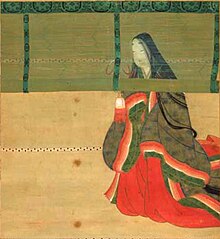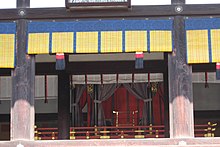
Back Sudare Catalan Sudare German Sudare Spanish سوداره Persian Sudare French Sudare Italian すだれ Japanese Sudare Vietnamese 簾 ZH-YUE




Sudare (簾/すだれ) are traditional Japanese screens or blinds, made of horizontal slats of decorative wood, bamboo, or other natural material, woven together with simple string, colored yarn, or other decorative material to make nearly solid blinds Sudare can be either rolled or folded up out of the way. They are also sometimes called misu (御簾/みす), particularly if they have a green fabric hem.[1] Yoshizu, non-hanging sudare, are made of vertical slats of common reed and used as screen.
Sudare are used in many Japanese homes to shield the verandah and other openings of the building from sunlight, rain, and insects. They are normally put up in spring and taken down again in autumn. Their light structure allows breezes to pass through, a benefit in the hot Japanese summers. Since the building materials are easy to find, sudare can be made cheaply.
Elaborate sudare for palaces and villas used high-quality bamboo, with expensive silk and gold embroidery worked in. Sometimes they featured paintings, most often on the inside; some Chinese screens had symbols painted on the outside as well.
© MMXXIII Rich X Search. We shall prevail. All rights reserved. Rich X Search